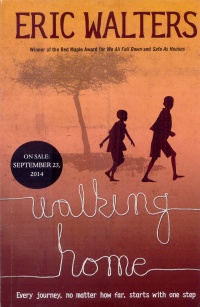| ________________
CM . . .
. Volume XXI Number 2. . . .September 12, 2014
excerpt:
With his latest work of juvenile fiction, Eric Walters adds to the growing list of Canadian children’s books that offer glimpses into war-torn corners around the world. Walking Home is suitable for readers aged 9 through 13 and will appeal to those who enjoyed Deborah Ellis’s “Breadwinner” series, Sharon McKay’s Thunder Over Kandahar, and Allan Stratton’s Chanda’s Wars. With many similarities to the above works, Walking Home is also familiar due to its predictable structure—that of the hero’s journey so common in fairy tales. Readers who might find the traumas endured by 13-year-old Muchoki and his little sister Jata overwhelming will be comforted by the structure’s implied certainty that everything will turn out all right. Indeed, the promise is implicit in the book’s title, Walking Home, so, of course the children arrive safely in the loving arms of their extended maternal family. Further, on their long walk from a refugee camp to their mother’s childhood village, Muchoki encounters helpers and overcomes obstacles similar to those readers will remember from fairy tales. Indeed, the characters, themselves, are barely more developed than those from the average fairy tale. And while the caring older brother succeeds in his quest due to the kindness of strangers rather than magic, Walking Home is no work of stark realism. Muchoki certainly does witness horrific violence when he witnesses his village ransacked in tribal warfare and his extended family murdered; indubitably he and his sister experience displacement in a refugee camp and are ultimately orphaned. But even so, Walking Home is far less gritty than it might be. Walters’ decision to provide hearty doses of hope throughout the tale results in obfuscation of many depths at play in tribal warfare and civil unrest. Therefore, readers familiar with actual political events in Kenya, as well as those expecting a more nuanced expose of the ways that postcolonial friction affects individuals in area of conflict, may take issue with how Walking Home reduces complex situations to a universal good versus evil binary. This deliberately oversimplified approach will certainly make the story more palatable for squeamish readers (not to mention adult gatekeepers), but what’s lost may come at too high a price. Nevertheless, Walking Home’s “digital companion” website promises background information, videos, and links that may supplement the depth lacking in the novel while exposing more of the realities at play in Kenya. Without the website, Walking Home is a hopeful story about perseverance and the power of humanity’s essential goodness to overcome all obstacles. As such, the book makes a satisfying story—but not a truly useful teaching tool for examining the plight of Kenyan refugees. Perhaps, though, the book alongside its digital companion will offer a perfect mix of hope and reality. Recommended with Reservations. Michelle Superle is an Assistant Professor at the University of the Fraser Valley, where she teaches children’s literature and creative writing courses. She has served twice as a judge for the TD Award for Canadian Children’s Literature and is the author of Black Dog, Dream Dog and Contemporary, English-language Indian Children’s Literature (Routledge, 2011).
To comment
on this title or this review, send mail to cm@umanitoba.ca.
Copyright © the Manitoba Library Association. Reproduction for personal
use is permitted only if this copyright notice is maintained. Any
other reproduction is prohibited without permission.
Next Review |
Table of Contents for This Issue
- September 12, 2014. |
